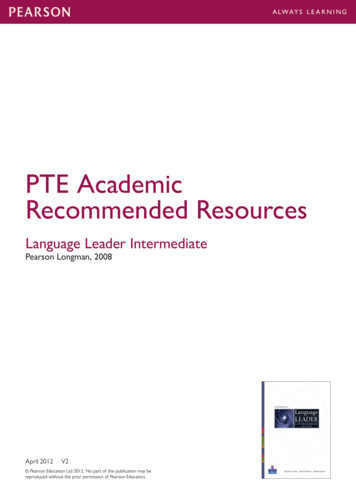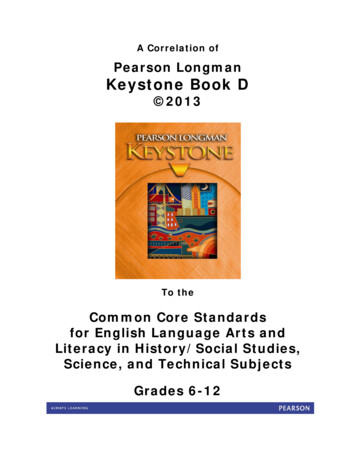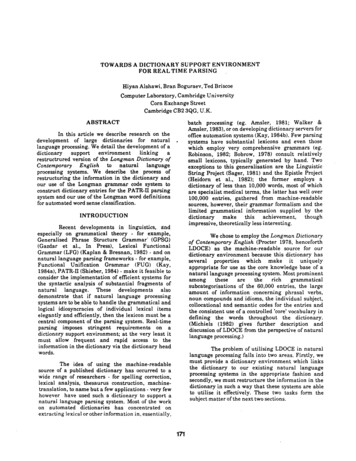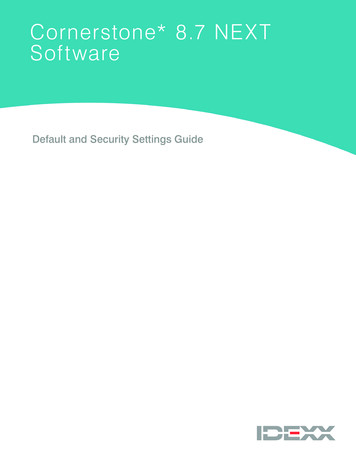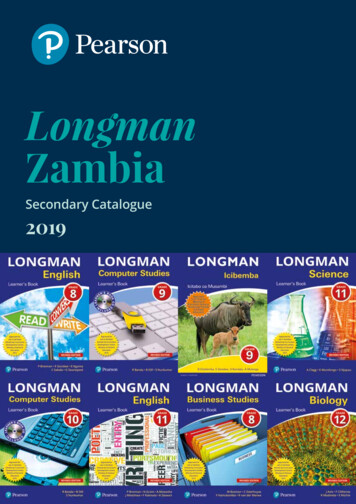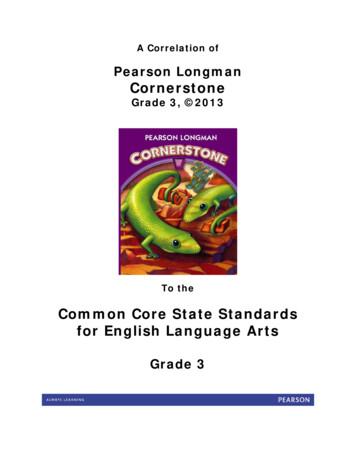
Transcription
A Correlation ofPearson LongmanCornerstoneGrade 3, 2013To theCommon Core State Standardsfor English Language ArtsGrade 3
A Correlation of Pearson Longman Cornerstone 2013To theCommon Core State Standards for English Language Arts, Grade 3IntroductionThis document demonstrates how Pearson Longman Cornerstone 2013 supports theCommon Core State Standards for English Language Arts. Correlation page references areto the Student Edition, Teacher Edition, and Teacher Resource Book. The Teacher ResourceBook references cite Units and Lessons. Lessons in the annotated Pearson LongmanCornerstone Teacher Editions contain the facsimile Student Edition, and references at pointof use to SIOP , AIMSweb , A Rise , and SELP2 (Stanford English Language ProficiencyTest).Pearson Longman Cornerstone is a multilevel program designed for elementary Englishlearners and struggling readers. The program blends rigorous, research-based reading andlanguage skills instruction together with a balance of content-area readings and ageappropriate, high-interest stories.Pearson Longman Cornerstone has been shown to dramatically increase studentachievement across all skill areas, particularly in reading comprehension, fluency, andwriting. Districts that are using Pearson Longman Cornerstone report significant gainsin standardized test scores within one year of implementation.In a trial study, a language assessment pre-test was administered in February 2008,prior to the start of the Cornerstone pilot. A post-test was administered in June2008 that showed impressive results: 108% increase in average class test scoresand an 181% increase in median test scores.Pearson Longman Cornerstone Highlights: Academic vocabulary acquisition is accelerated through explicit instruction Six thematic units per level organized around a Big Question provide a starting pointfor building understanding of key concepts and academic vocabulary. Each unit concludes with a variety of projects designed to provide evidence ofunderstanding through built-in differentiated instruction.2Key: SE Student Edition, TE Teacher Edition, TRB Teacher Resource Book
A Correlation of Pearson Longman Cornerstone 2013To theCommon Core State Standards for English Language Arts, Grade 3Table of ContentsReading Standards for Literature . 4Reading Standards for Informational Texts. 5Reading Standards for Foundational Skills . 8Writing Standards . 9Speaking and Listening Standards . 13Language Standards. 163Key: SE Student Edition, TE Teacher Edition, TRB Teacher Resource Book
A Correlation of Pearson Longman Cornerstone 2013To theCommon Core State Standards for English Language Arts, Grade 3Common Core Standards forEnglish Language ArtsGrade 3Reading Standards for LiteratureKey Ideas and DetailsLiterature 1. Ask and answer questions todemonstrate understanding of a text, referringexplicitly to the text as the basis for theanswers.Pearson LongmanCornerstone, Grade 3, 2013SE/TE: Think It Over, 15, 31, 49, 79, 97, 143,283; Reading Strategy: identify events in a plot,76, 79, 80; understand character, 12, 15, 16;identify sequence, 32, 170, 173; Link theReadings, 56, 120, 180, 244, 308, 370TRB: U1L6, U1L7, U1L13, U1L14, U1L15,U1L20, U1L21, U1L22, U1L29, U1L30, U2L6,U2L7, U2L8, U2L13, U2L14, U2L15, U2L29,U2L30, U3L6, U3L7, U3L8, U3L30, U4L30,U5L13, U5L14, U5L29Literature 2. Recount stories, including fables,folktales, and myths from diverse cultures;determine the central message, lesson, or moraland explain how it is conveyed through keydetails in the text.SE/TE: Literature: fable, 90–97; myths, 280–283; personal narrative, 42–47; play, 76–79;poem, 12–15, 140–143; short story, 26–31;Retell, 17, 33, 81, 99, 175, 285, 303, 349TRB: U1L8, U1L15, U1L22, U2L6, U2L7, U2L8,U2L15, U3L8, U5L14, U5L15Literature 3. Describe characters in a story(e.g., their traits, motivations, or feelings) andexplain how their actions contribute to thesequence of events.Craft and StructureLiterature 4. Determine the meaning of wordsand phrases as they are used in a text,distinguishing literal from non-literal language.SE/TE: Understand Character, 12, 15, 16–17TE only: Character, T14, T15TRB: U1L6, U1L7, U1L8, U1L13, U1L14, U1L20,U1L21, U1L29, U2L6, U2L7, U2L13, U2L14,U2L15, U2L29, U5L13, U5L14, U5L29SE/TE: For related activities see: Key Words(Words in Context), 8–9, 22–23, 38–39, 72–73,86–87, 104–105, 136–137, 152–153, 166–167,196–197, 214–215, 230–231, 260–261, 276–277, 290–291, 324–325, 338–339, 354–355TRB: U1L2, U1L4, U1L6, U1L7, U1L11, U1L13,U1L14, U1L18, U1L20, U1L21, U1L29, U1L30,U2L2, U2L4, U2L6, U2L7, U2L11, U2L13, U2L14,U2L29, U2L30, U3L2, U3L4, U3L6, U3L7, U3L30,U4L2, U4L18, U4L29, U4L30, U5L2, U5L11,U5L13, U5L14, U5L29, U6L2Literature 5. Refer to parts of stories, dramas,and poems when writing or speaking about atext, using terms such as chapter, scene, andstanza; describe how each successive part buildson earlier sections.SE/TE: Think It Over, 15, 31, 49, 79, 97, 143,283; Reading Strategy: identify events in a plot,76, 79, 80; understand character, 12, 15, 16;identify sequence, 32, 170, 173; Link theReadings, 56, 120, 180, 244, 308, 370TRB: U2L6, U2L7, U3L84Key: SE Student Edition, TE Teacher Edition, TRB Teacher Resource Book
A Correlation of Pearson Longman Cornerstone 2013To theCommon Core State Standards for English Language Arts, Grade 3Common Core Standards forEnglish Language ArtsGrade 3Literature 6. Distinguish their own point ofview from that of the narrator or those of thecharacters.Integration of Knowledge and IdeasLiterature 7. Explain how specific aspects of atext’s illustrations contribute to what isconveyed by the words in a story (e.g., createmood, emphasize aspects of a character orsetting).Literature 8. (Not applicable to literature)Literature 9. Compare and contrast thethemes, settings, and plots of stories written bythe same author about the same or similarcharacters (e.g., in books from a series).Pearson LongmanCornerstone, Grade 3, 2013SE/TE: For related material see: Think It Over,15, 31, 49, 79, 97, 143, 283; Reading Strategy:understand character, 12, 15, 16TE only: Visual Literacy: Illustrations, T13, T29,T31, T44, T47, T93, T95, T283, T29TRB: U1L6, U1L7, U1L13, U1L14, U1L20,U1L21, U1L29, U2L6, U2L7, U2L13, U2L14,U2L29, U3L6, U3L7, U4L18, U5L11, U5L13,U5L14Not applicable according to Common Core StateStandardsOpportunities to address this objective may befound on the following pages:SE/TE: Think It Over, 15, 31, 49, 79, 97, 143,283; Reading Strategy: identify events in a plot,76, 79, 80; understand character, 12, 15, 16;identify sequence, 32, 170, 173; Link theReadings, 56, 120, 180, 244, 308, 370TRB: U2L25, U3L25, U5L13, U5L14, U5L15,U5L25, U6L25Range of Reading and Level of Text ComplexityLiterature 10. By the end of the year, read and SE/TE: Further Reading, 57, 121, 181, 245,309, 371comprehend literature, including stories,dramas, and poetry, at the high end of theTE only: Further Reading, T57, T121, T181,grades 2–3 text complexity band independentlyT245, T309, T731and proficiently.TRB: U1L6, U1L7, U1L13, U1L14, U1L20,U1L21, U1L25, U2L6, U2L7, U2L13, U2L14,U2L25, U3L6, U3L7, U3L25, U4L25, U5L13,U5L14, U5L25, U6L25Reading Standards for Informational TextsKey Ideas and DetailsInformational Text 1. Ask and answerquestions to demonstrate understanding of atext, referring explicitly to the text as the basisfor the answers.SE/TE: Think It Over, 113, 159, 173, 205, 223,237, 269, 299, 331, 345, 363; A Closer Look at,48–49, 144–145, 206–207, 300–301, 346–347TRB: U1L21, U1L29, U1L30, U2L20, U2L21,U2L22, U2L29, U2L30, U3L6, U3L7, U3L13,U3L14, U3L15, U3L20, U3L21, U3L22, U3L29,U3L30, U4L6, U4L7, U4L8, U4L13, U4L14,U4L15, U4L20, U4L21, U4L22, U4L29, U4L30,U5L6, U5L7, U5L8, U5L20, U5L21, U5L29,U5L30, U6L6, U6L7, U6L8, U6L13, U6L14,U6L20, U6L21, U6L22, U6L29, U6L305Key: SE Student Edition, TE Teacher Edition, TRB Teacher Resource Book
A Correlation of Pearson Longman Cornerstone 2013To theCommon Core State Standards for English Language Arts, Grade 3Common Core Standards forEnglish Language ArtsGrade 3Informational Text 2. Determine the mainidea of a text; recount the key details andexplain how they support the main idea.Pearson LongmanCornerstone, Grade 3, 2013SE/TE: Strategies: identify main idea anddetails, 218, 223, 224TE only: Main Idea and Details, T220, T222,T223TRB: U3L15, U2L21, U3L13, U3L14, U3L20,U3L21, U3L29, U4L6, U4L7, U4L13, U4L14,U4L15, U4L20, U4L21, U4L22, U4L29, U5L6,U5L7, U5L8, U5L20, U5L21, U5L22, U5L29,U5L30, U6L6, U6L7, U6L8, U6L13, U6L14,U6L15, U6L20, U6L21, U6L22, U6L29Informational Text 3. Describe therelationship between a series of historicalevents, scientific ideas or concepts, or steps intechnical procedures in a text, using languagethat pertains to time, sequence, andcause/effect.Craft and StructureInformational Text 4. Determine the meaningof general academic and domain-specific wordsand phrases in a text relevant to a grade 3 topicor subject area.SE/TE: Strategies: identify steps in a process,174, 342, 345; identify cause and effect, 156,159, 160; identify problems and solutions, 200,205, 208; identify sequence, 32, 170, 173;Writing: Explain a Process, 242–243TRB: U2L22, U3L13, U3L14, U3L20, U3L21,U3L22, U4L6, U4L7, U4L8, U4L29, U6L13,U6L14, U6L15, U6L22, U6L29, U6L30SE/TE: Vocabulary: Words in context, 104–105,152–153, 166–167, 196–197, 214–215, 230–231, 260–261, 290–291, 324–325, 338–339,354–355TRB: U1L2, U1L5, U1L12, U1L19, U1L30, U2L2,U2L5, U2L12, U2L18, U2L19, U2L20, U2L21,U2L30, U3L2, U3L5, U3L11, U3L12, U3L13,U3L14, U3L18, U3L19, U3L20, U3L21, U3L29,U3L30, U4L2, U4L4, U4L5, U4L6, U4L7, U4L11,U4L12, U4L13, U4L14, U4L19, U4L20, U4L21,U4L30, U5L2, U5L4, U5L5, U5L6, U5L7, U5L12,U5L18, U5L19, U5L20, U5L21, U5L29, U5L30,U6L2, U6L4, U6L5, U6L6, U6L7, U6L11, U6L12,U6L13, U6L14, U6L18, U6L19, U6L20, U6L21,U6L306Key: SE Student Edition, TE Teacher Edition, TRB Teacher Resource Book
A Correlation of Pearson Longman Cornerstone 2013To theCommon Core State Standards for English Language Arts, Grade 3Common Core Standards forEnglish Language ArtsGrade 3Informational Text 5. Use text features andsearch tools (e.g., key words, sidebars,hyperlinks) to locate information relevant to agiven topic efficiently.Pearson LongmanCornerstone, Grade 3, 2013SE/TE: Use Pictures to Help withUnderstanding, 220; How to use a book, 385;How to read maps and diagrams, 388; How toread graphs, 389; Ask 5W Questions, 270; AskQuestions, 234, 237, 238; Writing and Research,405–411; Extension: Research, 147, 271;Graphic Organizers, 17, 51, 33, 81, 115, 147,161, 175, 209, 225, 239, 285, 303, 333, 349;Projects, 57, 121, 181, 245, 309, 371TE only: Internet, T7, T135, T195, T259, T323;Diagram or Drawing, T49; Extension: Research,T225Informational Text 6. Distinguish their ownpoint of view from that of the author of a text.Integration of Knowledge and IdeasInformational Text 7. Use information gainedfrom illustrations (e.g., maps, photographs), andthe words in a text to demonstrateunderstanding of the text (e.g., where, when,why, and how key events occur).SE/TE: For related material see: Think It Over,113, 159, 173, 205, 223, 237, 269, 299, 331,345, 363; Identify Fact and Opinion, 108, 113;Identify Author’s Purpose, 328, 331, 332SE/TE: How to use a book, 385; How to readmaps and diagrams, 388; How to read graphs,389; Ask 5W Questions, 270; Ask Questions,234, 237, 238TRB: U1L2, U1L3, U1L1, U1L11, U1L21, U1L29,U2L1, U2L2, U2L3, U2L20, U2L21, U2L29, U3L1,U3L2, U3L3, U3L6, U3L7, U3L11, U3L13, U3L14,U3L18, U3L20, U3L21, U4L1, U4L2, U4L3, U4L6,U4L7, U4L11, U4L13, U4L14, U4L20, U4L21,U4L29, U5L1, U5L2, U5L3, U5L4, U5L6, U5L7,U5L18, U5L20, U5L21, U6L1, U6L2, U6L3, U6L4,U6L6, U6L7, U6L11, U6L13, U6L14, U6L18,U6L20, U6L21, U6L29Informational Text 8. Describe the logicalconnection between particular sentences andparagraphs in a text (e.g., comparison,cause/effect, first/ second/third in a sequence).SE/TE: Strategies: identify steps in a process,174, 342, 345; identify cause and effect, 156,159, 160; identify problems and solutions, 200,205, 208; identify sequence, 32, 170, 173TRB: U3L13, U3L14, U3L15, U3L20, U3L21,U3L22, U4L6, U4L7, U4L87Key: SE Student Edition, TE Teacher Edition, TRB Teacher Resource Book
A Correlation of Pearson Longman Cornerstone 2013To theCommon Core State Standards for English Language Arts, Grade 3Common Core Standards forEnglish Language ArtsGrade 3Informational Text 9. Compare and contrastthe most important points and key detailspresented in two texts on the same topic.Pearson LongmanCornerstone, Grade 3, 2013SE/TE: Comprehension: compare and contrast,280, 283, 284; also see: My Family, 42–47; ACloser Look at: A Family Tree, 48–49; Animalsat Home, 140–143; A Closer Look at: Alligators,144–145; On Your Bike, Get Set, DONATE! 200–205; A Closer Look at: Bicycles, 206–207;Franklin’s Dream, 294–299; A Closer Look at:Space Exploration, 300–301; How to MakePuppets, 342–345; A Closer Look at: Puppets,346–347TRB: U2L25, U3L25, U4L25, U5L25, U6L25Range of Reading and Level of Text ComplexityInformational Text 10. By the end of the year, SE/TE: Further Reading, 57, 121, 181, 245,309, 371read and comprehend informational texts,including history/ social studies, science, andTE only: Further Reading, T57, T121, T181,technical texts, at the high end of the grades 2–T245, T309, T7313 text complexity band independently andproficiently.TRB: U1L25, U2L20, U2L21, U2L25, U3L13,U3L14, U3L20, U3L21, U3L25, U4L6, U4L7,U4L13, U4L14, U4L20, U4L21, U4L25, U5L6,U5L7, U5L20, U5L21, U5L25, U6L6, U6L7,U6L13, U6L14, U6L20, U6L21, U6L25Reading Standards for Foundational SkillsPrint ConceptsFoundational Skills 1. (Not applicable to Grade3)Not applicable according to Common Core StateStandardsPhonological AwarenessFoundational Skills 2. (Not applicable to Grade3)Not applicable according to Common Core StateStandardsPhonics and Word RecognitionFoundational Skills 3. Know and apply grade-level phonics and word analysis skills in decodingwords.Foundational Skills 3.a. Identify and know the SE/TE: Word Study: Prefixes and Suffixes, 89meaning of the most common prefixes andTRB: U2L12, U4L5derivational suffixes.Foundational Skills 3.b. Decode words withcommon Latin suffixes.SE/TE: Word Study: Prefixes and Suffixes, 89Foundational Skills 3.c. Decode multi-syllablewords.SE/TE: Word Study: Multi-Syllable Words, 357TRB: U2L12TRB: U6L198Key: SE Student Edition, TE Teacher Edition, TRB Teacher Resource Book
A Correlation of Pearson Longman Cornerstone 2013To theCommon Core State Standards for English Language Arts, Grade 3Common Core Standards forEnglish Language ArtsGrade 3Foundational Skills 3.d. Read gradeappropriate irregularly spelled words.Pearson LongmanCornerstone, Grade 3, 2013SE/TE: Key Words, 8–9, 22–23, 38–39, 72–73,86–87, 104–105, 136–137, 152–153, 166–167,196–197, 214–215, 230–231, 260–261, 276–277, 290–291, 324–325, 338–339, 354–355FluencyFoundational Skills 4. Read with sufficient accuracy and fluency to support comprehension.Foundational Skills 4.a. Read on-level textSE/TE: Fluency, 63, 127, 187, 251, 315, 379with purpose and understanding.TRB: U1L28, U2L28, U3L28, U4L28, U5L28,U6L28Foundational Skills 4.b. Read on-level proseand poetry orally with accuracy, appropriaterate, and expression on successive readings.SE/TE: Fluency, 63, 127, 187, 251, 315, 379Foundational Skills 4.c. Use context toconfirm or self-correct word recognition andunderstanding, rereading as necessary.SE/TE: Key Words, 8–9, 22–23, 38–39, 72–73,86–87, 104–105, 136–137, 152–153, 166–167,196–197, 214–215, 230–231, 260–261, 276–277, 290–291, 324–325, 338–339, 354–355;Academic Words, 10, 24, 40, 74, 88, 106, 138,154, 168, 198, 216, 232, 262, 278, 292, 326,340, 356TRB: U1L28, U2L28, U3L28, U4L28, U5L28,U6L28TRB: U1L28, U2L28, U3L28, U4L28, U5L28,U6L28Writing StandardsText Types and PurposesWriting 1. Write opinion pieces on familiar topicsWriting 1.a. Introduce the topic or text theyare writing about, state an opinion, and createan organizational structure that lists reasons.or texts, supporting a point of view with reasons.Opportunities to address this objective may befound on the following pages:SE/TE: Prewrite, 274, 288, 312; Draft, 288;Writing Checklist, 289, 307TRB: U5L10, U5L24, U5L27Writing 1.b. Provide reasons thatsupport the opinion.Opportunities to address this objective may befound on the following pages:SE/TE: Statement and Reasons, 274; Reasons,288, 306; Reasons to Persuade Reader, 312TRB: U5L27Writing 1.c. Use linking words and phrases(e.g., because, therefore, since, for example) toconnect opinion and reasons.Opportunities to address this objective may befound on the following pages:SE/TE: Writing Checklist, 275, 307TRB: U5L279Key: SE Student Edition, TE Teacher Edition, TRB Teacher Resource Book
A Correlation of Pearson Longman Cornerstone 2013To theCommon Core State Standards for English Language Arts, Grade 3Common Core Standards forEnglish Language ArtsGrade 3Writing 1.d. Provide a concludingstatement or section.Pearson LongmanCornerstone, Grade 3, 2013Opportunities to address this objective may befound on the following pages:SE/TE: Writing: Write a Persuasive Paragraph,274–275; Write a Prediction, 288–289; Write aPersuasive Letter, 306–307; Writing Workshop:Write a Book or Movie Review, 312–314TRB: U5L27Writing 2. Write informative/explanatory texts toinformation clearly.Writing 2.a. Introduce a topic and grouprelated information together; include illustrationswhen useful to aiding comprehension.examine a topic and convey ideas andSE/TE: Prewrite, 20, 36; Word Web, 54; ThreeColumn Chart, 228; Write a Research Question,336; Draft, 376TRB: U1L10, U1L17, U1L24, U1L27, U4L10,U4L17, U4L24, U4L27, U6L10Writing 2.b. Develop the topic with facts,definitions, and details.SE/TE: Prewrite, 20, 36, 228; Sequence Chart,242; Venn Diagram, 248; Make a Research Plan,337; How to Write a Paraphrase, 352–353; Howto Use Quotations, 368–369TRB: U1L27, U4L27Writing 2.c. Use linking words and phrases(e.g., also, another, and, more, but) to connectideas within categories of information.SE/TE: Writing Checklist, 21, 37, 55, 61, 249Writing 2.d. Provide a concluding statement orsection.SE/TE: For related material see: Writing:Describe a Person, 20–21; Describe a SummerDay, 36–37; Describe a Family Celebration, 54–55; Writing Workshop: Describe an Event, 60–62; Writing: Respond to Text, 228–229; Explaina Process, 242–243; Write to Compare andContrast, 248–250; Writing Workshop: Write aResearch Report, 374–378TRB: U1L27, U4L27TRB: U1L27, U4L27Writing 3. Write narratives to develop real or imagined experiences or events using effectivetechnique, descriptive details, and clear event sequences.Writing 3.a. Establish a situation and introduceSE/TE: Prewrite, 84, 124; Who are thea narrator and/or characters; organize an eventCharacters? 102sequence that unfolds naturallyTRB: U2L10, U2L17, U2L24, U2L27, U3L17,U3L24a, U3L27aWriting 3.b. Use dialogue and descriptions ofactions, thoughts, and feelings to developexperiences and events or show the response ofcharacters to situations.SE/TE: Prewrite, 102; Draft, 102; Facts andSensory Details, 118; Using Quotation Marks,119TRB: U2L10, U2L17, U2L2710Key: SE Student Edition, TE Teacher Edition, TRB Teacher Resource Book
A Correlation of Pearson Longman Cornerstone 2013To theCommon Core State Standards for English Language Arts, Grade 3Common Core Standards forEnglish Language ArtsGrade 3Writing 3.c. Use temporal words and phrases tosignal event order.Pearson LongmanCornerstone, Grade 3, 2013SE/TE: Draft, 84; Writing Checklist, 85, 103,119, 125TRB: U2L27, U3L24, U3L27Writing 3.d. Provide a sense of closure.SE/TE: Beginning, Middle, and End, 102, 124,125TRB: U2L27, U3L27Production and Distribution of WritingWriting 4. With guidance and support fromadults, produce writing in which thedevelopment and organization are appropriate totask and purpose. (Grade specific expectationsfor writing types are defined in standards 1–3above.)SE/TE: Writing Workshop, 60–62, 124–126,184–186, 248–250, 312–314, 374–378; Writing,20–21, 36–37, 54–55, 84–85, 102–103, 118–119, 150–151, 164–165, 178–179, 212–213,228–229, 242–243, 274–275, 288–289, 306–307, 336–337, 352–353, 368–369TRB: U1L10, U1L17, U1L24, U1L27, U1L28,U2L10, U2L17, U2L24, U2L27, U2L28, U3L10,U3L17, U3L24, U3L27, U3L28, U4L10, U4L17,U4L24, U4L27, U4L28, U5L10, U5L17, U5L24,U5L27, U5L28, U6L10, U6L17, U6L24, U6L27,U6L28Writing 5. With guidance and support frompeers and adults, develop and strengthen writingas needed by planning, revising, and editing.(Editing for conventions should demonstratecommand of Language standards 1–3 up to andincluding grade 3 on pages 28 and 29.)SE/TE: Writing Workshop, 60–62, 124–126,184–186, 248–250, 312–314, 374–378; Writing,20–21, 36–37, 54–55, 84–85, 102–103, 118–119, 150–151, 164–165, 178–179, 212–213,228–229, 242–243, 274–275, 288–289, 306–307, 336–337, 352–353, 368–369TRB: U1L2, U1L10, U1L17, U1L24, U1L25,U1L27, U1L28, U2L2, U2L10, U2L17, U2L24,U2L27, U2L28, U3L2, U3L10, U3L17, U3L24,U3L27, U3L28, U4L2, U4L10, U4L17, U4L24,U4L27, U4L28, U5L2, U5L10, U5L17, U5L24,U5L27, U5L28, U6L2, U6L10, U6L17, U6L24,U6L27, U6L28Writing 6. With guidance and support fromadults, use technology to produce and publishwriting (using keyboarding skills) as well as tointeract and collaborate with others.SE/TE: Writing Workshop, 60–62, 124–126,184–186, 248–250, 312–314, 374–378; Writing,20–21, 36–37, 54–55, 84–85, 102–103, 118–119, 150–151, 164–165, 178–179, 212–213,228–229, 242–243, 274–275, 288–289, 306–307, 336–337, 352–353, 368–369; Projects:Writing, 57, 121, 181, 245, 309, 37111Key: SE Student Edition, TE Teacher Edition, TRB Teacher Resource Book
A Correlation of Pearson Longman Cornerstone 2013To theCommon Core State Standards for English Language Arts, Grade 3Common Core Standards forEnglish Language ArtsGrade 3Research to Build and Present KnowledgeWriting 7. Conduct short research projects thatbuild knowledge about a topic.Pearson LongmanCornerstone, Grade 3, 2013SE/TE: Plan a Research Report, 336–337; Howto Write a Paraphrase, 352–353; How to UseQuotations, 368–369; Writing Workshop: Writea Research Report, 374–378; Writing andResearch, 405–411; Extension: Research, 147,271TE only: Extension: Research, T225TRB: U6L10, U6L17, U6L24, U6L27Writing 8. Recall information from experiencesor gather information from print and digitalsources; take brief notes on sources and sortevidence into provided categories.SE/TE: Plan a Research Report, 336–337; Howto Write a Paraphrase, 352–353; How to UseQuotations, 368–369; Writing Workshop: Writea Research Report, 374–378; Writing andResearch, 405–411; Extension: Research, 147,271TE only: Extension: Research, T225TRB: U3L7, U3L8, U4L7, U6L10, U6L17, U6L24,U6L27Writing 9. (Begins in grade 4)Range of WritingWriting 10. Write routinely over extended timeframes (time for research, reflection, andrevision) and shorter time frames (a singlesitting or a day or two) for a range of disciplinespecific tasks, purposes, and audiences.Not applicable according to Common Core StateStandardsSE/TE: Writing Workshop, 60–62, 124–126,184–186, 248–250, 312–314, 374–378; Writing,20–21, 36–37, 54–55, 84–85, 102–103, 118–119, 150–151, 164–165, 178–179, 212–213,228–229, 242–243, 274–275, 288–289, 306–307, 336–337, 352–353, 368–369; Projects:Writing, 57, 121, 181, 245, 309, 371TRB: U1L2, U1L10, U1L17, U1L24, U1L25,U1L27, U1L28, U2L2, U2L10, U2L17, U2L24,U2L27, U2L28, U3L2, U3L10, U3L17, U3L24,U3L27, U3L28, U4L2, U4L10, U4L17, U4L24,U4L27, U4L28, U5L2, U5L10, U5L17, U5L24,U5L27, U5L28, U6L2, U6L10, U6L17, U6L24,U6L27, U6L2812Key: SE Student Edition, TE Teacher Edition, TRB Teacher Resource Book
A Correlation of Pearson Longman Cornerstone 2013To theCommon Core State Standards for English Language Arts, Grade 3Common Core Standards forEnglish Language ArtsGrade 3Pearson LongmanCornerstone, Grade 3, 2013Speaking and Listening StandardsComprehension and CollaborationSpeaking/Listening 1. Engage effectively in a range of collaborative discussions (one-on-one, ingroups, and teacher led) with diverse partners on grade 3 topics and texts, building on others’ ideasand expressing their own clearly.SE/TE: What about you? 7, 71, 135, 195, 259,Speaking/Listening 1.a. Come to discussions323; The Big Question, 3, 12, 16, 26, 32, 42,prepared, having read or studied requiredmaterial; explicitly draw on that preparation and 50, 56, 67, 76, 80, 90, 98, 108, 120, 131, 140,156, 170, 180, 205, 264, 280, 294, 308, 319,other information known about the topic to328, 342, 358, 370; Think It Over, 15, 31, 47,explore ideas under discussion.79, 97, 113, 143, 159, 173, 205, 217, 223, 237,283, 299, 331, 345, 363; Discussion, 56, 120,180, 244, 308, 370TRB: U1L2, U1L3, U1L4, U1L5, U1L9, U1L1,U1L11, U1L12, U1L16, U1L18, U1L19, U1L23,U1L25, U1L26, U2L1, U2L2, U2L3, U2L4, U2L5,U2L9, U2L11, U2L12, U2L16, U2L18, U2L19,U2L23, U2L25, U2L26, U3L1, U3L2, U3L3, U3L4,U3L5, U3L9, U3L11, U3L12, U3L16, U3L18,U3L19, U3L23, U3L25, U3L26, U4L1, U4L2,U4L3, U4L4, U4L5, U4L9, U4L11, U4L12, U4L15,U4L16, U4L18, U4L19, U4L23, U4L26, U5L1,U5L2, U5L3, U5L4, U5L5, U5L9, U5L11, U5L12,U5L16, U5L18, U5L19, U5L22, U5L23, U5L25,U5L26, U6L1, U6L2, U6L3, U6L4, U6L5, U6L9,U6L11, U6L12, U6L16, U6L18, U6L19, U6L23,U6L25, U6L26Speaking/Listening 1.b. Follow agreed-uponrules for discussions (e.g., gaining the floor inrespectful ways, listening to others with care,speaking one at a time about the topics andtexts under discussion).SE/TE: What about you? 7, 71, 135, 195, 259,323; The Big Question, 3, 12, 16, 26, 32, 42,50, 56, 67, 76, 80, 90, 98, 108, 120, 131, 140,156, 170, 180, 205, 264, 280, 294, 308, 319,328, 342, 358, 370; Think It Over, 15, 31, 47,79, 97, 113, 143, 159, 173, 205, 217, 223, 237,283, 299, 331, 345, 363; Discussion, 56, 120,180, 244, 308, 370TRB: U1L2, U1L3, U1L4, U1L5, U1L9, U1L1,U1L11, U1L12, U1L16, U1L18, U1L19, U1L23,U1L25, U1L26, U2L1, U2L2, U2L3, U2L4, U2L5,U2L9, U2L11, U2L12, U2L16, U2L18, U2L19,U2L23, U2L25, U2L26, U3L1, U3L2, U3L3, U3L4,U3L5, U3L9, U3L11, U3L12, U3L16, U3L18,U3L19, U3L23, U3L25, U3L26, U4L1, U4L2,U4L3, U4L4, U4L5, U4L9, U4L11, U4L12, U4L15,U4L16, U4L18, U4L19, U4L23, U4L26, U5L1,U5L2, U5L3, U5L4, U5L5, U5L9, U5L11, U5L12,U5L16, U5L18, U5L19, U5L22, U5L23, U5L25,U5L26, U6L1, U6L2, U6L3, U6L4, U6L5, U6L9,U6L11, U6L12, U6L16, U6L18, U6L19, U6L23,U6L25, U6L2613Key: SE Student Edition, TE Teacher Edition, TRB Teacher Resource Book
A Correlation of Pearson Longman Cornerstone 2013To theCommon Core State Standards for English Language Arts, Grade 3Common Core Standards forEnglish Language ArtsGrade 3Speaking/Listening 1.c. Ask questions tocheck understanding of information presented,stay on topic, and link their comments to theremarks of others.Pearson LongmanCornerstone, Grade 3, 2013SE/TE: What about you? 7, 71, 135, 195, 259,323; The Big Question, 3, 12, 16, 26, 32, 42,50, 56, 67, 76, 80, 90, 98, 108, 120, 131, 140,156, 170, 180, 205, 264, 280, 294, 308, 319,328, 342, 358, 370; Think It Over, 15, 31, 47,79, 97, 113, 143, 159, 173, 205, 217, 223, 237,283, 299, 331, 345, 363; Discussion, 56, 120,180, 244, 308, 370TRB: U1L2, U1L3, U1L4, U1L5, U1L9, U1L1,U1L11, U1L12, U1L16, U1L18, U1L19, U1L23,U1L25, U1L26, U2L1, U2L2, U2L3, U2L4, U2L5,U2L9, U2L11, U2L12, U2L16, U2L18, U2L19,U2L23, U2L25, U2L26, U3L1, U3L2, U3L3, U3L4,U3L5, U3L9, U3L11, U3L12, U3L16, U3L18,U3L19, U3L23, U3L25, U3L26, U4L1, U4L2,U4L3, U4L4, U4L5, U4L9, U4L11, U4L12, U4L15,U4L16, U4L18, U4L19, U4L22, U4L23, U4L25,U4L26, U5L1, U5L2, U5L3, U5L4, U5L5, U5L9,U5L11, U5L12, U5L16, U5L18, U5L19, U5L23,U5L25, U5L26, U6L1, U6L2, U6L3, U6L4, U6L5,U6L9, U6L11, U6L12, U6L16, U6L18, U6L19,U6L23, U6L25, U6L26Speaking/Listening 1.d Explain their ownideas and understanding in light of thediscussion.SE/TE: What about you? 7, 71, 135, 195, 259,323; The Big Question, 3, 12, 16, 26, 32, 42,50, 56, 67, 76, 80, 90, 98, 108, 120, 131, 140,156, 170, 180, 205, 264, 280, 294, 308, 319,328, 342, 358, 370; Think It Over, 15, 31, 47,79, 97, 113, 143, 159, 173, 205, 217, 223, 237,283, 299, 331, 345, 363; Discussion, 56, 120,180, 244, 308, 370TRB: U1L19, U1L25, U2L4, U2L25, U3L25,U4L25, U5L25, U6L25Speaking/Listening 2. Determine themain ideas and supporting details of atext read aloud or information presentedin diverse media and formats, includingvisually, quantitatively, and orally.SE/TE: Think It Over, 15, 31, 47, 79, 97, 113,143, 159, 173, 205, 217, 223, 237, 283, 299,331, 345, 363; The Big Question, 3, 12, 16, 26,32, 42, 50, 56, 67, 76, 80, 90, 98, 108, 120,131, 140, 156, 170, 180, 205, 264, 280, 294,308, 319, 328, 342, 358, 370TRB: U1L26, U2L26, U3L26, U4L26, U5L26,U6L2614Key: SE Student Edition, TE Teacher Edition, TRB Teacher Resource Book
A Correlation of Pearson Longman Cornerstone 2013To theCommon Core State Standards for English Language Arts, Grade 3Common Core Standards forEnglish Language ArtsGrade 3Speaking/Listening 3. Ask and answerquestions about information from a speaker,offering appropriate elaboration and detail.Pearson LongmanCornerstone, Grade 3, 2013SE/TE: What about you? 7, 71, 135, 195, 259,323; The Big Question, 3, 12, 16, 26, 32, 42,50, 56, 67, 76, 80, 90, 98, 108, 120, 131, 140,156, 170, 180, 205, 264, 280, 294, 308, 319,328, 342, 358, 370TE only: Extension, T17, T51, T81, T99, T115,T147, T209, T225, T271, T303, T333TRB: U1L15, U1L26, U2L8, U2L26, U3L26,U4L26, U5L26, U6L26Presentation of Knowledge and
writing. Districts that are using Pearson Longman Cornerstone report significant gains in standardized test scores within one year of implementation. In a trial study, a language assessment pre-test was administered in February 2008, prior to the start of the Cornerstone pilot. A post-test was administered in June 2008 that showed impressive results: 108% increase in average class test scores .
